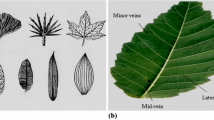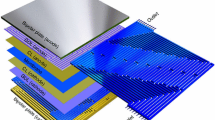Abstract
The effects of anode, cathode, and cooling channels for a Proton Exchange Membrane Fuel Cell (PEMFC) on flow fields have been investigated numerically. Continuous open-faced fluid flow channels formed in the surface of the bipolar plates traverse the central area of the plate surface in a plurality of passes such as a serpentine manner. The pressure distributions and velocity profiles of the hydrogen, air and water channels on bipolar plates of the PEMFC are analyzed using a two-dimensional simulation. The conservation equations of mass, momentum, and energy in the three-dimensional flow solver are modified to include electro-chemical characteristics of the fuel cell. In our three-dimensional numerical simulations, the operation of electro-chemical in Membrane Electrolyte Assembly (MEA) is assumed to be steady-state, involving multi-species. Supplied gases are consumed by chemical reaction. The distributions of oxygen and hydrogen concentration with constant humidity are calculated. The concentration of hydrogen is the highest at the center region of the active area, while the concentration of oxygen is the highest at the inlet region. The flow and thermal profiles are evaluated to determine the flow patterns of gas supplied and cooling plates for an optimal fuel cell stack design.
Similar content being viewed by others
Abbreviations
- A :
-
The pre-exponential factor
- \(\bar C_p \) :
-
Mean constant pressure specific heat [J/kg-K]
- \(\bar C_p^0 \) :
-
Reference constant pressure specific heat [J/kg-K]
- \(\bar C\) :
-
Mean constant volume specific heat
- D m :
-
Molecular diffusivity [m2/s]
- e :
-
Internal energy [W/m2]
- E a :
-
Activation energy for the reaction
- F h,j :
-
Diffusional thermal energy flux in directionX j [W/m2]
- F m,j :
-
Diffusional flux component in directionX j
- h :
-
Static enthalpy [J/kg]
- K i :
-
Porosity [m3/m3]
- H m :
-
Heat of formation [J/kg]
- k :
-
Thermal conductivity [W/nvK.]
- m :
-
Mass [kg]
- m m :
-
Mass fraction of mixture constituent
- m :
-
Mass flow rate [kg/s]
- M :
-
Molecular weight
- n :
-
Number of cell
- P :
-
Piezometric pressure [Pa]
- P e :
-
Total power in the stack [Watts]
- Q :
-
Heating rate [Watts]
- S m :
-
Mass source
- Sh :
-
Energy source
- S i :
-
Momentum source
- T :
-
Temperature [K]
- T o :
-
Reference temperature [K]
- U i :
-
Superficial velocity [m/s]
- U j :
-
Absolute fluid velocity [m/s]
- \(\bar u_j \) :
-
Relative velocity in fluid local coordinate frame [m/s]
- U a :
-
Fraction of the air usage
- U h :
-
Fraction of the hydrogen usage
- V c :
-
Cell voltage [V]
- X j :
-
Cartesian coordinate frame
- ρ:
-
Density [kg/m3]
- β:
-
Temperature exponent
- βi :
-
Permeability
- μ:
-
Viscosity [N-s/m2]
- τij :
-
Viscous stress tensor [N/m2]
- ξj :
-
Orthotropic direction
- Π:
-
Product of all constituents
- Σ:
-
Summation over all mixture constituents
References
Baschuk, J. J. and Li Xianguo, 2000, “Modeling of Polymer Electrolyte Membrane Fuel Cells with Variable Degrees of Water Flooding,”J. Power Sources, Vol. 86, Issues 1-2, pp. 181- 196.
Bernardi, D.M. and Verbrugge, M. W., 1992, “A Mathematical Model of a Solid Polymer Electrolyte Fuel Cell,”J. Electrochem Soc., Vol. 139, No. 9, pp. 2477–2491.
Costamagna, P., 2001, “Transport Phenomena in Polymeric Membrane Fuel Cells,”Chem. Eng. Sci., Vol. 56, Issue 2, pp. 323–332.
Dutta, S., Shimpalee, S. and Van Zee, J. W., 2001, “Numerical Prediction of Mass-Exchange Between Cathode and Anode Channels in a PEM Fuel Cell,”J. Heat and Mass Transfer, Vol. 44, Issue 2, pp. 2029–2042.
EG & G Services Parsons Inc., 2000,Fuel Cell Handbook, No. DE-AM26-99FT40575.
Fand, R. M., Kim, B. Y. K., Lam, A. C. C. and Phan, R. T., 1987, “Resistance to the Flow of Fluid through Simple and Complex Porous Media Whose Matrices are Composed of Randomly Packed Spheres.”ASME J. Fluids Engineering, Vol. 109, pp. 268–274.
Fuller, T. F. and Newman, J., 1993, “Water and Thermal Management in Solid Polymer Electrolyte Fuel Cells,”J. Electrochem Soc., Vol. 140, No. 5, pp. 1218–1225.
Gunes, M. B., 2001, “Investigation of a Fuel Cell Based Total Energy System for Residential Application,” M. S. Mechanical Eng., Virginia Poly-technique Institute of University.
He, W. and Chen, Q., 1998, “Three-Dimensional Simulation of a Molten Carbonate Fuel Cell Stack under Transient Conditions,”J. of Power Sources, Vol. 55, Issue 1, pp. 25–32.
Jung, S. Y. and Nguyen, T. V., 1998, “An Alongthe-Channel Model for Proton Exchange Membrane Fuel Cells,”J. Electrochem. Soc., Vol. 145, pp. 1149–1159.
Larminie, J. and Dicks, A., 2000,Fuel Cell Systems Explained, John Wiley & Sons, Inc.
Lee, J. H. and Lalk, T. R., 1998, “Modeling Fuel Cell Stack Systems,”J. Power Sources, Vol. 73, Issue 2, pp. 229–241.
Mann, R. F., 2000, “Development and Application of a Generalized Steady-State Electrochemical Model for a PEM Fuel Cell,”J. Power Sources, Vol. 86, Issues 1-2, pp. 173–180.
Nguyen, T. V. and White, R. E., 1993, “A Water and Heat Management Model for Proton- Exchange Membrane Fuel Cells,”J. Electrochem. Soc., Vol. 140, No. 8, pp. 2178–2186.
Raznjevic, K., 1995,Handbook of Thermodynamic Tables, Begell House, Inc.
Singh, D., Lu, D. M. and Djilali. N., 1999, “A Two-Dimensional Analysis of Mass Transport in Proton Exchange Membrane Fuel Cell,”J. Eng. Soc., Vol. 37, pp. 431–452.
Springer, T. E., Zawodzinski, T. A. and Gottesfeld, S., 1991. “Polymer Electrolyte Fuel Cell Model,”J. Electrochem Soc., Vol.138, No. 8, pp. 2334–2342.
Standaert, F., Hemmes, K. and Woudstra, N., 1996, “Analytical Fuel Cell Modeling,”J. of Power Sources, Vol. 63, Issue 2, pp. 221–234.
Suares. G. E. and Hoo, K. A., 2000, “Parameter Estimation of a Proton-Exchange Membrane Fuel Cell Using Voltage-Current Data,”Chem. Eng. Soc., Vol. 55, pp. 2237–2247.
Tuomas Mennola, 2000, “Design and Experiment Characterization of Polymer Electrolyte Membrane Fuel Cells,”Master’s Thesis, Department of Engineering Physics and Mathematics, Helsinki University of Technology.
Um, S. K., Wang, C. Y. and Chen, K. S., 2000, “Computational Fluid Dynamics Modeling of Proton Exchange Membrane Fuel Cells,”J. Electrochem. Soc., Vol. 147, No. 12, pp. 4485–4493.
Verbrugge, M. W. and Hill, R. F., 1990, “Transport Phenomena in Perfluorosulfonic Acid Membrane during the Passage of Current,”J. Electrochem Soc., Vol. 137, pp. 1131–1138.
Wang, Z. H., Wang, C. Y. and Chen, K. S., 2001, “Two-Phase Flow and Transport in the Air Cathode of Proton Exchange Membrane Fuel Cells,”J. Power Sources, Vol. 94, Issue 1, pp. 1- 11.
Author information
Authors and Affiliations
Corresponding author
Rights and permissions
About this article
Cite this article
Jung, HM., Koo, JY. Thermal and flow analysis in a proton exchange membrane fuel cell. KSME International Journal 17, 1358–1370 (2003). https://doi.org/10.1007/BF02982477
Received:
Revised:
Published:
Issue Date:
DOI: https://doi.org/10.1007/BF02982477




